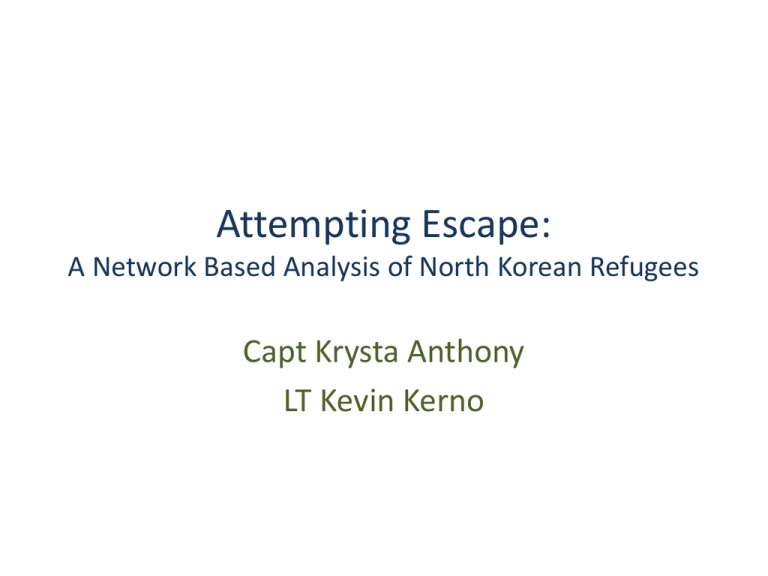
Attempting Escape:
A Network Based Analysis of North Korean Refugees
Capt Krysta Anthony
LT Kevin Kerno
Historical Background
• History of North Korea
• Human rights issues
• What is the rest of the world doing?
North Korean Escapees
• 1,500 North Koreans escaped in 2012
– So what’s the big deal?
• Extremely arduous/perilous journey
– Difficult to travel within in North Korea
– Geography
– Government agents
– Sex Traffickers
– Kidnappers
• China illegally deports North Korean refugees
– Classifies North Korean refugees as “economic
immigrants”
How does one escape?
• The “New Underground Railroad”
– Who is helping
– What makes it up
– How it works
• Where do the refugees go?
– China first
– Then exit into Mongolia and Southeast Asia
• Reaching South Korea
General Escape Routes
Map of North Korea
Problem Statement
What are the best routes for North Korean
escapees to take when fleeing from North
Korea?
Research Questions
• What is the shortest route an escapee can
take to fully escape?
• What is the safest route an escapee can take?
• What general route provides the highest
likelihood of escape?
• Where are the most likely points of
interdiction both inside of North Korea and in
China?
• How can resources be allocated to assist
North Korean refugees escape?
Challenges in Creating Network
• Limited published information and data
• Most information is word of mouth and
anecdotal
• Pieced multiple accounts and sources together
• Utilized Google Earth
• Utilized geographical data, topographical
maps, and intuition
Assumptions/Project Limitations
• Three starting points in North Korea that
represent southern, central, and northern regions
• Considering a single escapee
• All edge probabilities within North Korea are the
same
– Similar for border crossings and within China
• Only considered straight line distances
• The only escape paths out of NK are into China
• If in China, an escapee must escape to Mongolia
or Southeast Asia to be considered safe
• Average speed refugees moving is 10 km/hr for
14 hours per day
Overview of Network
• Nodes: Cities, towns, villages, border crossing
points, and airports in North Korea, China,
Mongolia, and Southeast Asia
• Edges: Straight line routes between the above
nodes
– Super sink to Escape from Bangkok, Ulaanbaatar,
Vientiane, Manila and Seoul
• Edge Costs: Initially the straight line distance in
kilometers
– Then assigned probabilities of evading authorities to
each edge
Network
Shortest Path Escape Route
Start Point: Kyo-Hwa-So
Haeju
Pungsan
4
Total Distance: 2139
2244
2279 km
Analysis: Basic Model
• Shortest path routes in terms of distance from
three starting points within North Korea
• Results
– All paths lead to Chinggis-Khaan International
Airport in Mongolia
– Refugee must travel over 2200 km
• Conclusion
– Average total travel time with no delays would be
17 days
– Tumen River crossing is longest
More Realistic Edge Costs
• Scaled the overall edge lengths
• To determine edge probabilities we took the
following into account:
– Where the edge is located (i.e. North Korea, China,
between North Korea and China, etc.)
– What locations the edge is linking
– The overall edge length in km
• Rate of capture on an edge (percent):
– 20%/hour: North Korea Edges
– 30%/hour: North Korea into China border crossing
– 10%/hour: China edges
More Realistic Edge Costs
• To generate edge probabilities we applied the
following transformation
Probability of Evading = e
pt
p rate of capture on edge [% / hour ]
t time an escapee is on an edge [ hours ]
More Realistic Edge Costs
• We then take the –ln of the probability of
evading to use as our new edge costs:
ln(Probability of Evading)
• Now, the goal is to maximize the overall
probability of escape
Probabilistic Escape Route
Start Point: Pungsan
Haeju
Kyo-Hwa-So
4
POE: 5.9%
11.4%
16.0%
Analysis: More Realistic Model
• Highest probabilities of escaping from the
three starting points
– No interdiction
• Results
– Highest probability of escape: 16.0%
– Lowest probability of escape: 5.9%
• Conclusions
– All escape routes through Capital International
Airport in Beijing
– Tumen River crossing most dangerous
Interdiction
• Forms of attack
– North Korean agents and government informants
– Chinese agents and government informants
– Kidnappers
– Sex traffickers
– Human trafficking organizations
• Modeled attacks on an edge by placing a
“checkpoint” on that edge
Implementing Attacks
• “Checkpoint” encompasses all above forms of
attack
• No “checkpoints” outside of China and North
Korea
• Checkpoints are not 100% effective
– Each “checkpoint” causes a 6-hour delay
• Looked at a varying number of checkpoints to
determine effect on safest path
Probabilistic Escape Routes
with 5 Checkpoints
Haeju
Kyo-Hwa-So
4
Start Point: Pungsan
1.40%
2.07%
POE: 1.10%
Analysis: More Realistic Model with
Interdiction
• Highest probabilities of escaping from the
three starting points with attacks
• Results
– Highest probability of escape: 2.04%
– Lowest probability of escape: 1.10%
– Non-nested solutions
• Conclusions
– “Checkpoints” do not alter paths, only drastically
decrease probability of escape
– Tumen River crossing most dangerous
Operator Resilience Curve
Network Design
• Adding resources to certain routes
• Increasing probabilities of successful border
crossing
– Increasing the number of border crossings
– Increasing the number of guides
– Paying off government agents
• With more resources, more escapees could
escape through Beijing airport
– Enhances their chances of escape
– Avoids hundreds of miles of ground travel
Network Design: Additional Resources
along Pungsan Route
Conclusions and Insights
• Shortest path escape path greatly different
than probability-based escape path
• Tumen River Route
– Longest of shortest path in distance
– Most dangerous probabilistically
– Addition of resources triples probability of escape
• Keys to increasing the probability of escape
– Get escapees to the Beijing airport
– Add additional resources in China
Additional Research Opportunities
• More detailed/accurate network
– Roads, railways, bus routes, etc.
• Changing probabilities
– Lower escape probabilities out of concentration
camps
– Vary probabilities in China
• Use maximum flow to solve the problem
• Further implementation of network design
aspects
Questions









